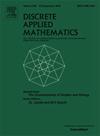Comparing the p-independence number of regular graphs to the q-independence number of their line graphs
IF 1
3区 数学
Q3 MATHEMATICS, APPLIED
引用次数: 0
Abstract
Let be a simple graph and let denote the line graph of . A -independent set in is a set of vertices such that the subgraph induced by has maximum degree at most . The -independence number of , denoted by , is the cardinality of a maximum -independent set in . In this paper, and motivated by the recent result that independence number is at most matching number for regular graphs Caro et al., (2022), we investigate which values of the non-negative integers , , and have the property that for all r-regular graphs. Triples having this property are called valid -triples. Among the results we prove are:
- •is valid -triple for , , and .
- •is valid -triple for and .
- •is valid -triple for , , and even.
- •is valid -triple for , , and odd with .
将正则图的p独立数与其线形图的q独立数进行比较
让G是一个简单的图,让L (G)表示G . p-independent集的线形图G是一组顶点S⊆V (G)的子图引起的年代已经最大程度最多p。p-independence G,用αp (G),是最大的基数p-independent设置在G .本文出于最近结果,独立数是最多匹配数正则图卡罗et al .,(2022),我们调查的值非负整数p, q,和r对于所有r正则图都具有αp(G)≤αq(L(G))的性质。具有这种性质的三元组(p,q,r)称为有效的α-三元组。证明了•(p,q,r)对于p≥0,q≥3,r≥2是有效的α-三重,•(p,q,r)对于p≤q<;3,r≥2是有效的α-三重,•(p,q,r)对于p≥0,q=2, r为偶数是有效的α-三重,•(p,q,r)对于p≥0,q=2, r为奇数,r =max{3,17(p+1)16}是有效的α-三重。我们还证明了未确定的可能有效α-三元组、线性流产猜想和路径覆盖猜想之间的密切关系。
本文章由计算机程序翻译,如有差异,请以英文原文为准。
求助全文
约1分钟内获得全文
求助全文
来源期刊

Discrete Applied Mathematics
数学-应用数学
CiteScore
2.30
自引率
9.10%
发文量
422
审稿时长
4.5 months
期刊介绍:
The aim of Discrete Applied Mathematics is to bring together research papers in different areas of algorithmic and applicable discrete mathematics as well as applications of combinatorial mathematics to informatics and various areas of science and technology. Contributions presented to the journal can be research papers, short notes, surveys, and possibly research problems. The "Communications" section will be devoted to the fastest possible publication of recent research results that are checked and recommended for publication by a member of the Editorial Board. The journal will also publish a limited number of book announcements as well as proceedings of conferences. These proceedings will be fully refereed and adhere to the normal standards of the journal.
Potential authors are advised to view the journal and the open calls-for-papers of special issues before submitting their manuscripts. Only high-quality, original work that is within the scope of the journal or the targeted special issue will be considered.
 求助内容:
求助内容: 应助结果提醒方式:
应助结果提醒方式:


